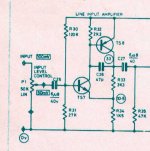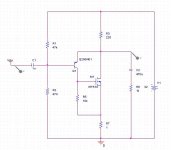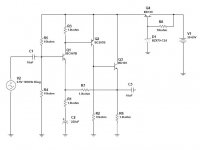Dear Sirs,
please excuse my maybe silly following question.
I have a preamp circuit that needs a +/- 30 V dual power supply.
Can I use instead a +/- 24 V dual PS without changing any components value ?
I can understand that the circuit should be optimized for the use of a 30V Ps, but it would be the possible result with a 24V PS?
I ask this because sometime I see amps that can work with different voltage supplies without modifications.
Thank you very much indeed.
Kind regards,
beppe61
please excuse my maybe silly following question.
I have a preamp circuit that needs a +/- 30 V dual power supply.
Can I use instead a +/- 24 V dual PS without changing any components value ?
I can understand that the circuit should be optimized for the use of a 30V Ps, but it would be the possible result with a 24V PS?
I ask this because sometime I see amps that can work with different voltage supplies without modifications.
Thank you very much indeed.
Kind regards,
beppe61
Netlist said:I'm afraid that will be impossible to tell without schematic.
/Hugo
Dear Mr. Hugo,
thank you very much indeed for your kind reply.
I am attaching the schematic.
BC107 and BC303 are the bjts to be used in the original circuit.
Besides, do you think that I can use a BD140 instead of the BC303 ? I like its TO126 package.
It can work also with a single 0-60V supply, but I decided for a dual PS.
I intend to use 24V fixed voltage regulators for the first prototype.
In general I am extremely interested in minimalist circuit for line preamps and I am collecting them in orderd to build the best one day.
Any kind suggestion would be very welcome and appreciated here.
Kind regards,
beppe61
Attachments
If you use max 30 volts single supply you can use almost any BCxxx transistor. The circuit doesn't get better with a dual supply, adds nothing really.beppe61 said:It can work also with a single 0-60V supply, but I decided for a dual PS.
I intend to use 24V fixed voltage regulators for the first prototype.
BC547-550
BC557-560
BC337, BC327
plus many many more will work.
Netlist said:A BD140 will work but this design was made for a single supply. Also 60 V will be a little high for the BC107.
/Hugo
Dear Mr. Hugo,
thanks for the kind reply.
It is a schematic of a commercial product that was very well reviewed in its time.
I strongly think that it could compare very well also with more modern preamps.
And it is amazingly simple (just 2 bjts) for not being also interesting.
Yes, the power supply is single 0-60V.
Actually I have already built a one-channel prototype and the BC107 does not get warm in any way.
Needless to say the sound was very very promising.
Instead the BC303 needs to be cooled down.
So I would prefer to use a BD140 that has a TO126 package, very much more user friendly.
I thought to use a dual power supply beacuse the vast majority of the solid state preamps use dual PS.
And choosing +/- 24V I could use ready off-the-shelf voltage regulators (very simple, convenient and cheap also).
Thank you very much indeed.
Kind regards,
beppe61
peranders said:Dear Mr. Peranders,
thank you very much indeed for your extremely kind and helpful reply.
Let me ask you something more about your statements.
" If you use max 30 volts single supply you can use almost any BCxxx transistor ".
I would like to use a high voltage power supply because I read somewhere that this should have a greatly beneficial impact on dynamic response of the preamp (excuse me but my tecnichal background and englis knowledge are both at neanderthal level).
" The circuit doesn't get better with a dual supply, adds nothing really".
I thought about a dual PS because almost all commercial preamps use a dual PS.
Also a dual +/- 24V PS is easily done with off-the-shelf regulators.
Thank you very much indeed.
Kind regards,
beppe61
beppe61 said:I am attaching the schematic.
I have built something very similiar (i call the topology "ultra-linear" pair) and it does sound very good. It doesn't really benefit from dual rails, as indicated by others.
My favorite is a small signal PNP (5401) coupled with a hot small signal n-channel MOSFET (irf510). It sounds great to my ears.
beppe61 said:This is not true. Often it's in fact a disadvantage to have too high supply voltage. A basic rule is the have enough voltage, not unnecessarily high, and not too low oft course.peranders said:" If you use max 30 volts single supply you can use almost any BCxxx transistor ".
I would like to use a high voltage power supply because I read somewhere that this should have a greatly beneficial impact on dynamic response of the preamp (excuse me but my tecnichal background and englis knowledge are both at neanderthal level).
beppe61 said:I'm afraid you have missed the concept WHY you have a dual voltage. The main reason is to get rid of all coupling caps but in your case you can't.Originally posted by peranders " The circuit doesn't get better with a dual supply, adds nothing really".
I thought about a dual PS because almost all commercial preamps use a dual PS.
Also a dual +/- 24V PS is easily done with off-the-shelf regulators.
peranders said:
This is not true. Often it's in fact a disadvantage to have too high supply voltage. A basic rule is the have enough voltage, not unnecessarily high, and not too low oft course.
I'm afraid you have missed the concept WHY you have a dual voltage. The main reason is to get rid of all coupling caps but in your case you can't.
Dear Mr. Peranders,
I thank you sincerely for your kind and great help.
Let's see if I have understood every thing correctly at the end.
You suggest:
1) to stick with a 0-30V single PS
2) with a 30V single supply I can use all the NPN-PNP couples you mention in the circuit attached without having to change the values of the passive components.
Have I understood well?
Last question: do you think that the coupling caps must be avoided definitely or it is more a problem of choosing the right caps for the task? I mean a great quality film cap.
On the other hand all tube preamps are cap coupled, also those very expensive ones.
Thank you very much indeed for you kind and very precious advice.
Kind regards,
beppe61
tlf9999 said:
I have built something very similiar (i call the topology "ultra-linear" pair) and it does sound very good.
It doesn't really benefit from dual rails, as indicated by others.
My favorite is a small signal PNP (5401) coupled with a hot small signal n-channel MOSFET (irf510).
It sounds great to my ears.
Dear Sir,
thank you very much indeed for your kind and interesting reply.
Maybe you were expecting this, but I would be immensely grateful if you could give me some more details about the circuit you built.
Is the circuit protect by a copyright?
Thank you very much indeed.
Kind regards,
beppe61
If you have 1 V rms out (or so) 30 V will quite enough in order to have dynamic headroom.
This two transistor solution isn't extremely good but it's rather pedagogical and easy to simulate so it's excellent as a newbeginner project. I recommend you download LTSpice from linear.com You can also see the distortion in this software.
I think you should forget for a moment what's expensive and supposed to be good and also how the circuit solution looks like.
This two transistor solution isn't extremely good but it's rather pedagogical and easy to simulate so it's excellent as a newbeginner project. I recommend you download LTSpice from linear.com You can also see the distortion in this software.
I think you should forget for a moment what's expensive and supposed to be good and also how the circuit solution looks like.
No cap can't sound bad but some cap may sound something but not necessarily bad. Caps cost money also and are rather large compared to other parts.beppe61 said:Last question: do you think that the coupling caps must be avoided definitely or it is more a problem of choosing the right caps for the task? I mean a great quality film cap.
Personally I avoid caps in the signal path but this am I. I also use dual supplies. You can check my homepage and see what I have done so far.
tlf9999 said:here is what I have. R7 can be ignored and no value is critical. As designed, the irf device runs pretty hot but you can easily dial in back by using higher value R3.
Dear Sir,
thank you so much for showing all the circuit details.
This is very kind of you indeed.
Now, I have some more questions:
1) is the voltage supply single and 0-32V ?
2) what is the gain of the circuit?
3) what is the output impedance of the circuit (i.e. can it drive also low impedance loads?).
4) must the mos-fet be heathsinked?
Thank you very much again
Kind regards,
beppe61
peranders said:
... You can check my homepage and see what I have done so far.
Dear Mr. Peranders,
first of all I would like to congratulate for the really great and amazing web site.
It will take me a long time to analyze all the projects your offer.
I can feel also the very high quality of all the products.
In the next days I will try to study your proposal for line level amplification (my presente nightmare).
Just one technical question:
when you design a circuit which are the test you perform on it to assess its quality?
I mean, distorition spectra, time impulse response, etc.
Thank you very much again.
Kind regards,
beppe61
it has a single 32v supply. You can pretty much use anything above 12v without adjustment.
this is a buffer so gain is about 1x.
never measured its output impedance but it can drive down to 110ohm loads without any ill effect.
in this design, yes. You can up R3 so that the mosfet doesn't dissipate as much power.
this is a buffer so gain is about 1x.
never measured its output impedance but it can drive down to 110ohm loads without any ill effect.
in this design, yes. You can up R3 so that the mosfet doesn't dissipate as much power.
tlf9999 said:> it has a single 32v supply. You can pretty much use anything above 12v without adjustment.
That is very nice. A lot of choice then for voltage supply.
Also nice to have no trimmer to set.
> this is a buffer so gain is about 1x.
It suits me fine.
> never measured its output impedance but it can drive down to 110ohm loads without any ill effect.
Very very good. I could drive almost everything.
> in this design, yes. You can up R3 so that the mosfet doesn't dissipate as much power.
Also very interesting.
I think that I will build a prototype very soon and report my impressions.
Thank you sincerely for your great help.
Kind regards,
beppe61
- Status
- This old topic is closed. If you want to reopen this topic, contact a moderator using the "Report Post" button.
- Home
- Amplifiers
- Solid State
- I'm back - the silly questions guy.


